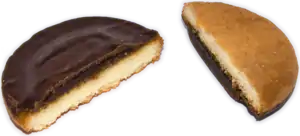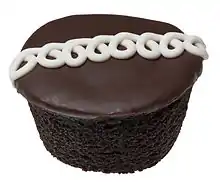Jaffa Cakes
Jaffa Cakes are biscuit-sized cakes introduced by McVitie and Price in the UK in 1927 and named after Jaffa oranges. The most common form of Jaffa cakes are circular, 2 1⁄8 inches (54 mm) in diameter and have three layers: a Genoise sponge base, a layer of orange flavoured jam and a coating of chocolate.[1] Each cake is 46 calories. Jaffa cakes are also available as bars or in small packs, and in larger and smaller sizes.[2] The original Jaffa Cakes now come in packs of 10, 20, 30, or 40, having been downsized in 2017 from 12 or 24 per pack.[3]
 A Jaffa Cake cut in half | |
| Alternative names | Jaffa |
|---|---|
| Type | Cake |
| Place of origin | United Kingdom |
| Region or state | All Regions |
| Created by | McVitie and Price |
| Main ingredients | Sponge cake, orange-flavoured jam, chocolate |
| Variations | Various limited edition flavours (Lemon and lime, strawberry, black currant) |
Because McVitie's did not register the name "Jaffa Cakes" as a trademark, other biscuit manufacturers and supermarkets have made similar products under the same name.[4] The product's classification as a cake or biscuit was part of a VAT tribunal in 1991, with the court finding in McVitie's favour that the Jaffa cake should be considered a cake for tax purposes.[5] In 2012 they were ranked the best selling cake or biscuit in the United Kingdom.[6]
Manufacture
McVitie's entire line of Jaffa cakes are produced in the United Kingdom at the McVitie's factory in Stockport.[7] The Jaffa cake production area covers an acre (4,000 m2) and includes a production line over a mile (1.6 km) long which sits on the Stockport side of the site's boundary with Manchester.[4] Because of the nature of the product – having multiple components of cake, chocolate covering and jam – special hardware accelerators were devised to allow rapid computer inspection of 20 products per second, taking place under four symmetrically placed lights.[8]
Flavour variants
Although Jaffa cakes are usually orange flavour, limited edition flavours have been available, such as lemon-and-lime,[9] strawberry[10] and blackcurrant.[11] McVities launched limited-edition pineapple flavour Jaffa cakes in early 2020.[12] In early 2021 with the new flavours of cherry and passionfruit.[13]
Taxation
In the United Kingdom, value added tax is payable on chocolate-covered biscuits, but not on chocolate-covered cakes.[14] McVities defended its classification of Jaffa Cakes as cakes at a VAT tribunal in 1991, against the ruling that Jaffa cakes were biscuits due to their size and shape, and the fact that they were often eaten in place of biscuits.[15] McVities insisted that the product was a cake, and allegedly produced a giant Jaffa cake in court to illustrate its point.[15] The product was assessed on the following criteria:[16][17]
- The product's name was regarded as a minor consideration.
- The ingredients were regarded as similar to those of a cake, producing a thin cake-like batter rather than the thick dough of a biscuit.
- The product's texture was regarded as being that of a sponge cake.
- The product hardens when stale, in the manner of a cake.
- A substantial part of the Jaffa cake, in terms of bulk and texture, is sponge.
- In size, the Jaffa cake is more like a biscuit than a cake.
- The product was generally displayed for sale alongside other biscuits, rather than with cakes.
- The product is presented as a snack and eaten with the fingers, like a biscuit, rather than with a fork as a cake might be. The tribunal also considered that children would eat them in "a few mouthfuls", in the manner of a sweet.
The court found in favour of McVitie's and ruled that the product should be considered a cake, meaning that VAT is not paid on Jaffa cakes in the United Kingdom.[14][18]
The Irish Revenue Commissioners also regard Jaffa cakes as cakes, since their moisture content is greater than 12%. As a result, they are charged the reduced rate of VAT (13.5% as of 2016).[19]
References
- "Labelling rules". Food Standards Agency. 9 April 2008. Archived from the original on 20 July 2008.
- "Jaffa Cake's lemon squeezy bar". Thegrocer.co.uk. Archived from the original on 29 September 2011. Retrieved 25 August 2010.
- "Jaffa Cakes packet size reduced in latest 'shrinkflation' move". The Guardian. Retrieved 29 May 2020.
- Harry Wallop (6 May 2012). "Jaffa Cakes - definitely not biscuits - prepare to take on imitators". The Daily Telegraph. Archived from the original on 25 August 2012. Retrieved 3 January 2013.
- "VAT Tribunal case LON/91/0160 (United Biscuits)". Archived from the original on 10 February 2019. Retrieved 9 February 2019.
- "Jaffa Cakes - definitely not biscuits - prepare to take on imitators" Archived 17 June 2018 at the Wayback Machine. The Daily Telegraph. Retrieved 28 December 2014
- "The factory where life is sweet". Manchester Evening News. 17 April 2012. Retrieved 24 July 2013.
- Mark Graves; Bruce Batchelor (2003). Machine Vision for the Inspection of Natural Products. Springer Science & Business Media. p. 403. ISBN 978-1-85233-525-0.
- "McVitie's Jaffa Cakes Lemon and Lime". Snackspot.org.uk. Archived from the original on 26 July 2011. Retrieved 22 June 2010.
- "McVitie's launches limited edition Strawberry-flavoured Jaffa Cakes". Talkingretail.com. 27 April 2009. Retrieved 22 June 2010.
- "Jaffa Cakeover". The Daily Record. 12 December 2005. Retrieved 22 June 2010.
- Abernethy, Laura (27 January 2020). "McVitie's launches new pineapple flavour Jaffa Cakes". Metro. Retrieved 7 March 2020.
- uk.style.yahoo.com https://uk.style.yahoo.com/mcvities-launched-jaffa-cake-flavours-104700577.html?_fsig=GFtWnczlZBm_YVyKLY3AnQ--~A. Retrieved 27 January 2021. Missing or empty
|title=(help) - Lee, Natalie (2011). Revenue Law Principles and Practice. A&C Black. p. 1009. ISBN 9781847667663.
- "What you do – and don't – pay VAT on". Which? Magazine. 24 June 2010. Archived from the original on 5 September 2012. Retrieved 27 September 2012.
- "United Kingdom VAT & Duties Tribunals Decisions – Torq Ltd v Revenue and Customs [2005]". British and Irish Legal Information Institute. Retrieved 27 September 2012.
- "Excepted items: Confectionery: The bounds of confectionery, sweets, chocolates, chocolate biscuits, cakes and biscuits: The borderline between cakes and biscuits". hmrc.gov.uk. Archived from the original on 17 April 2013. Retrieved 28 April 2013.
- "The borderline between cakes and biscuits". Archived from the original on 17 April 2013. Retrieved 28 April 2013.
- "Archived copy". Archived from the original on 7 January 2018. Retrieved 7 January 2018.CS1 maint: archived copy as title (link) CS1 maint: bot: original URL status unknown (link)

